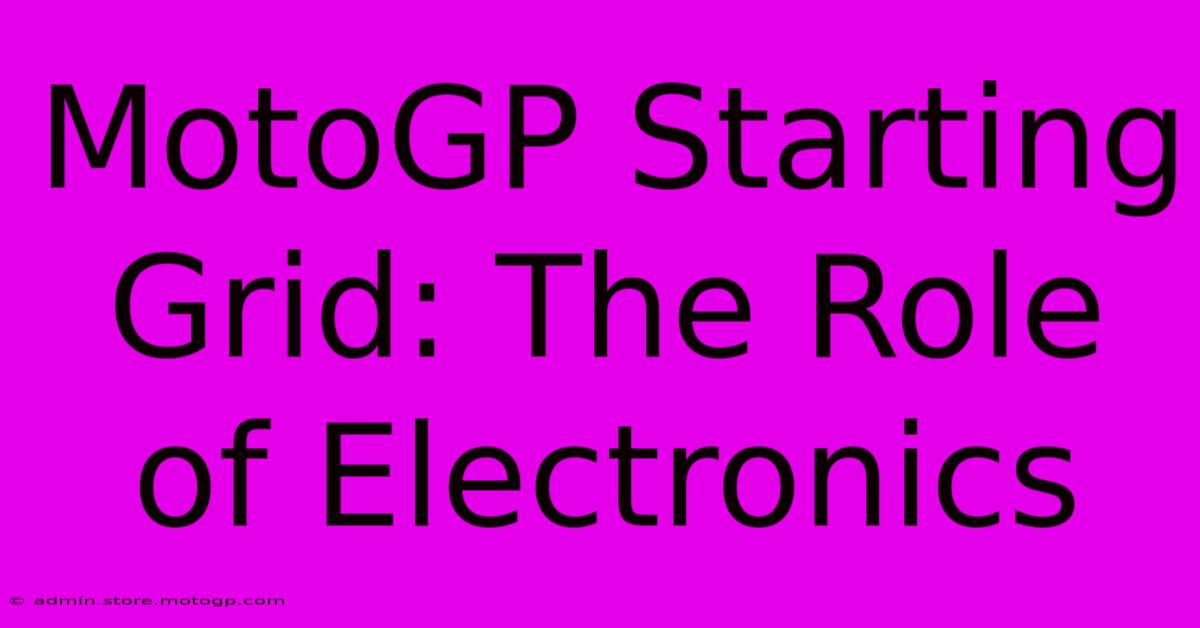MotoGP Starting Grid: The Role Of Electronics

Table of Contents
MotoGP Starting Grid: The Role of Electronics
The roar of the engines, the smell of burning rubber, the tension in the air – the start of a MotoGP race is electrifying. But beyond the raw power and adrenaline, a crucial element often overlooked is the sophisticated role of electronics in determining the starting grid and ultimately, the race outcome. This isn't just about the bikes themselves; it's about the intricate interplay of technology, strategy, and rider skill.
From Qualifying to Grid Position: A Technological Dance
Securing a prime spot on the starting grid is paramount in MotoGP. A good starting position significantly improves a rider's chances of winning. The qualifying sessions, however, are not just about brute speed; they’re a high-stakes test of electronic precision.
Traction Control and Launch Control: The Unsung Heroes
Two key electronic systems play a pivotal role in achieving a fast lap time during qualifying and a clean getaway at the race start:
-
Traction Control: This system monitors the rear wheel's spin, preventing wheelspin and ensuring optimal power delivery, particularly crucial when exiting corners at high speeds. A well-tuned traction control system allows riders to push their bikes to the limit without losing control, leading to faster lap times and better qualifying positions. Different track conditions require different traction control settings, highlighting the importance of rider-electronics synergy.
-
Launch Control: This system manages engine power and wheel spin during the initial acceleration off the line. It helps riders maximize traction and achieve the fastest possible start without losing control. This is a critical aspect, as a smooth, powerful launch can make or break a race. Getting the launch control setting just right is crucial for getting ahead of the pack in the chaotic first few corners.
Telemetry and Data Analysis: The Strategic Edge
Beyond the rider's skill and the bike's capabilities, data plays a massive role. Telemetry systems continuously gather vast amounts of data during practice and qualifying sessions. This data, including speed, acceleration, braking, lean angles, and engine parameters, is meticulously analyzed by engineers. This analysis helps pinpoint areas for improvement in the bike's setup, rider technique, and electronic system settings.
The optimal settings for traction control and launch control aren't static; they're adjusted based on the gathered data, the track conditions, and even the rider's preferences. This iterative process of data collection, analysis, and adjustment is crucial in achieving the best possible starting grid position.
Beyond the Starting Line: The Ongoing Impact
The influence of electronics doesn't end with the starting grid. Throughout the race, the electronic systems continue to play a crucial role in managing engine performance, braking, and stability. A rider's ability to effectively utilize these systems can mean the difference between victory and defeat. The constant refinement of these systems, driven by cutting-edge technology and relentless data analysis, is pushing the boundaries of motorcycle racing.
The Future of Electronics in MotoGP
The future promises even more sophisticated electronic systems that could revolutionize MotoGP racing. Expect to see further advancements in areas such as:
- Advanced rider aids: More intuitive and responsive systems that seamlessly integrate with the rider's inputs.
- Predictive analytics: Algorithms that anticipate track conditions and optimize electronic settings accordingly.
- Artificial intelligence: AI-powered systems that learn and adapt to rider preferences and track conditions, potentially leading to even faster lap times and improved consistency.
The MotoGP starting grid is a testament to the incredible advancements in electronic technology. While rider skill remains paramount, the intricate dance between human skill and electronic precision is what truly defines modern MotoGP. The future will likely see an even greater reliance on sophisticated electronics, blurring the line further between human and machine.

Thank you for visiting our website wich cover about MotoGP Starting Grid: The Role Of Electronics. We hope the information provided has been useful to you. Feel free to contact us if you have any questions or need further assistance. See you next time and dont miss to bookmark.
Featured Posts
-
Moto Gps Most Inspiring Comebacks After Accidents
Feb 20, 2025
-
Moto Gp Sprint Races The Next Level Of Competition
Feb 20, 2025
-
Motorcycle Racing Celebrating Achievements In All Categories
Feb 20, 2025
-
The Legacy Of Speed Austin Sprint Race Time Impact
Feb 20, 2025
-
Cota Track Day Your Journey To Mastery
Feb 20, 2025
